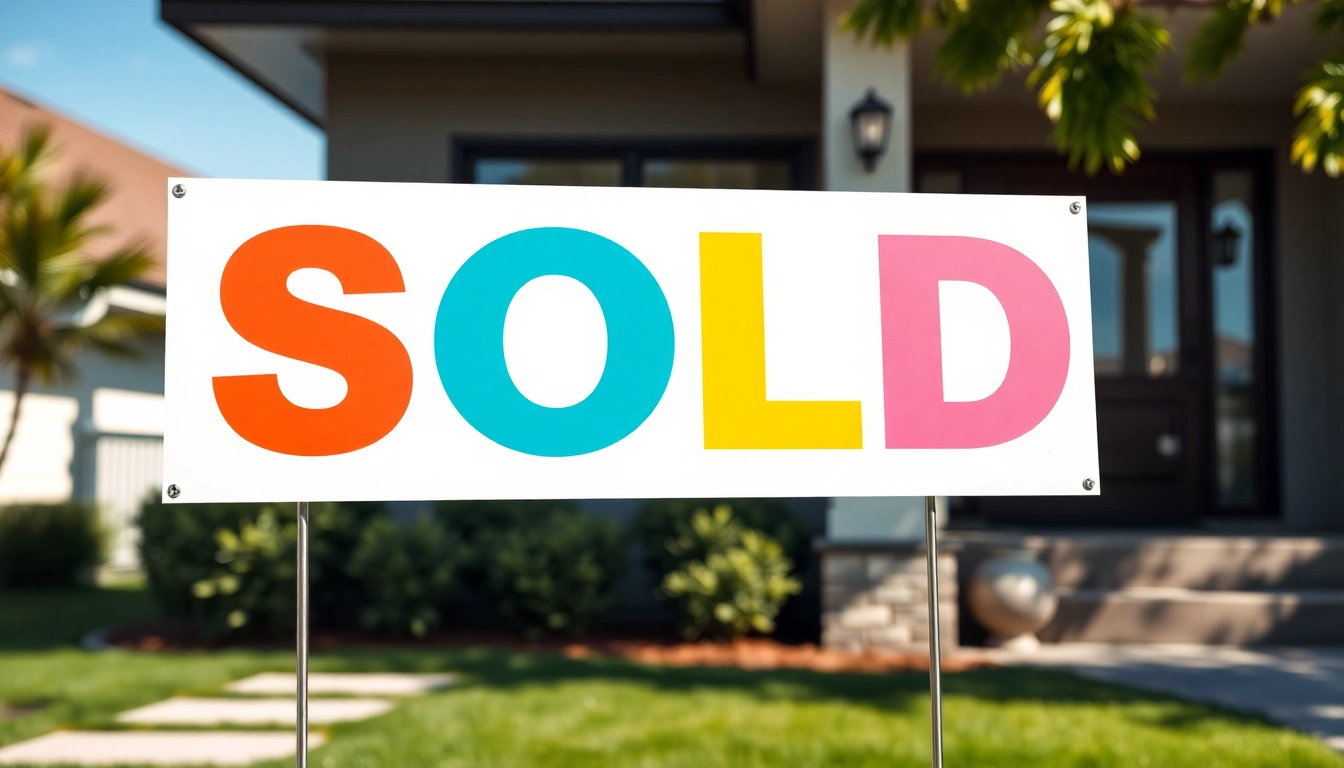Understanding the Importance of Sold Signs in Real Estate
In the competitive world of real estate, marketing tools play a pivotal role in closing deals and establishing a reputation. Among these tools, sold signs are not merely markers indicating a property has been sold—they are powerful symbols of success, credibility, and professional competence. They serve as vital communication assets that inform prospective buyers, reinforce a realtor’s brand, and generate vital leads that can turn into future business opportunities.
Understanding the multifaceted role of sold signs in property marketing is fundamental for real estate professionals. From influencing perceptions to complying with industry regulations, the strategic use of sold signs can significantly amplify a listing’s visibility and impact. This comprehensive guide explores the different dimensions of sold signs, offering actionable insights that will elevate your branding, increase sales efficiency, and maximize ROI.
The Role of Sold Signs in Property Marketing
At their core, sold signs serve as immediate visual indicators that a property is no longer available and has successfully transferred ownership. They contribute to a sense of transparency in the marketplace, reassuring potential clients and fostering trust in your professionalism. Moreover, well-designed sold signs are a form of mobile advertising—capturing the attention of pedestrians, motorists, and neighbors alike.
Research indicates that properties with eye-catching sold signs attract more inquiries, facilitating quicker sales cycles. For instance, a 2023 survey published by the National Association of Realtors found that approximately 65% of buyers initially learn about properties through signage or word-of-mouth, with sold signs being a prominent touchpoint.
Another critical aspect is the exposure of your success stories. Every sold sign effectively communicates that your agency is active, competent, and results-oriented, stimulating organic interest and referrals. They also play a vital role in neighborhood branding, signaling that your agency is a reliable resource in a specific locale.
How Sold Signs Influence Buyer and Seller Perceptions
From a buyer’s perspective, an attractive and professionally crafted sold sign subconsciously communicates trustworthiness and authority. When buyers see a property marked as sold, it reinforces the vibrant activity within the local market, reducing perceived risks associated with buying. Well-designed signs with clear messaging convey that the home was sold swiftly and effectively—creating a sense of desirability for other listings handled by the same agent.
For sellers, a sold sign serves as a bragging point and a testament to your skills. It demonstrates that you can get properties off the market efficiently, giving prospective clients confidence in your capabilities. Realtors who utilize personalized, branded sold signs tend to enjoy higher brand recognition and stronger market presence.
Furthermore, the placement and design elements of sold signs influence perceptions of professionalism. Cluttered, faded, or poorly positioned signs may diminish credibility, whereas high-quality signs with sharp graphics and strategic placement can elevate your professional image.
Legal and Ethical Considerations for Real Estate Signage
While deploying sold signs is a common practice, ethical and legal standards must be observed to ensure compliance and maintain professionalism. The National Association of Realtors (NAR) and local regulations govern signage regarding size, placement, and content to prevent misleading claims or obstruction of public spaces.
Real estate agents should be aware of local ordinances that specify on which properties sold signs can be placed, how large they can be, and restrictions regarding signage during certain hours or in specific zones. For example, some municipalities prohibit signs from obstructing visibility at intersections or sidewalks, emphasizing safety and community aesthetics.
Ethically, sold signs should accurately reflect the transaction status. Using misleading language like “Pending” or “Under Contract” or removing signs prematurely can harm reputation and violate industry standards. Always ensure the signage clearly states when a property is sold, and adhere to branding guidelines to avoid misrepresentations.
In addition, compliance also entails respecting property rights; signs should be placed on the property or authorized areas and not infringe on private property without permission. Familiarity with local signage codes and maintaining transparent, truthful messaging preserves your integrity and fosters trust with clients and the community.
Types and Features of Effective Sold Signs
Different Materials: Plastic, Wood, Magnetic Signs
The choice of material significantly impacts the durability, appearance, and perceived value of your sold signs. Each material offers unique advantages tailored to specific needs and aesthetics.
- Plastic Signs: Made predominantly from corrugated or PVC plastic, these signs are lightweight, weather-resistant, and affordable. They are ideal for temporary use, such as during active sales or open houses, but can also be designed for long-term durability.
- Wood Signs: Offering a classic, high-end look, wood signs convey craftsmanship and sophistication. They are robust and can be customized with intricate designs or painted branding. However, they tend to be more expensive and require maintenance against the elements.
- Magnetic Signs: Designed with magnetic backing, these signs can be easily attached and removed from metal surfaces like doors or fences. They are reusable, flexible, and perfect for agents who want quick updates or temporary signage without leaving permanent marks.
Choosing the right material depends on factors such as the local climate, budget, branding goals, and the desired level of permanence. For high-visibility neighborhoods, durable, weatherproof options might be preferable, while for a boutique agency, handcrafted wood signs could enhance perceived value.
Customization Options: Logos, Colors, Messaging
Customizable sold signs are essential for reinforcing your branding and making your signs stand out. They facilitate the communication of key messaging, showcase your agency’s identity, and foster memorable branding.
- Logos and Branding: Including your logo ensures instant recognition. It reinforces brand consistency across all marketing channels and enhances professionalism.
- Color Schemes: Bright, contrasting colors like red, yellow, or orange improve visibility and immediate recognition. Colors should align with your brand palette, maintaining consistency while ensuring the sign grabs attention.
- Messaging: Clear, concise messages such as “Sold,” “Just Sold,” or “Congratulations” communicate the transaction status effectively. Additional details like agent contact info, QR codes, or social media handles can also be added to boost engagement and lead generation.
Incorporating relevant graphics, fonts, and layouts ensures your signs are not only attractive but also easy to read from a distance. Custom signage providers offer design templates and experienced assistance to craft compelling, high-impact sold signs tailored to your specific branding and marketing objectives.
Innovative Features: QR Codes, Digital Integration
Staying ahead in real estate marketing involves leveraging technology integrated into sold signs. QR codes, digital displays, and augmented reality (AR) features are transforming static signage into interactive tools that engage prospects.
- QR Codes: Embedding QR codes on sold signs allows passersby to instantly access property details, virtual tours, or your contact information. This seamless connection boosts engagement and can help convert passersby into leads.
- Digital Signage: Electronic signs with dynamic content enable real-time updates. For example, a digital “Sold” sign can feature changing messages or animations, capturing more attention.
- Augmented Reality: Some innovative signs can be scanned via AR apps to reveal additional multimedia content, such as 3D home tours or agent portfolios, adding a modern touch to your marketing arsenal.
Investing in these advanced features may involve higher initial costs, but they significantly enhance your market differentiation, lead capture, and overall brand credibility.
Design Best Practices for Maximizing Visibility
Color Schemes That Stand Out
Color plays a vital role in capturing attention and conveying professionalism. High-contrast color combinations, such as black on yellow, white on red, or blue on white, ensure the sign is easily seen from various distances and lighting conditions. Using consistent brand colors helps reinforce recognition, while accent colors can highlight key messages like “Sold” or “Open House.”
Typography for Quick Readability
Font choice directly impacts how quickly your message is understood. Sans-serif fonts like Arial, Helvetica, or Futura are preferred for outdoor signage, as they are clean and legible from afar. Font sizes should be proportionate to the sign size, with the primary message (e.g., “Sold”) prominently displayed in large, bold lettering. Supporting information should be smaller but still readable from a distance.
Placement Tips for Optimal Exposure
Even the best signage can underperform if poorly placed. Strategic positioning involves placing signs where they are highly visible to foot and vehicle traffic, such as at busy intersections, along main roads, and in neighborhood entrances. Height is crucial—signs should be mounted at eye level without obstructing views or violating local ordinances. Avoid cluttered areas to ensure the sign stands out clearly.
Timing also matters; placing signs early in the selling process ensures maximum exposure. Regular checks to maintain the sign’s visibility, cleanliness, and structural integrity are critical for long-term effectiveness.
Implementation Strategies for Realtors
Manufacturing and Ordering Process
Partnering with reliable signage manufacturers ensures high-quality products that meet your branding standards. Before ordering, define your design specifications, including size, material, colors, and messaging. Request prototypes or samples to evaluate quality and visibility. Lead times vary; plan your orders well in advance of listing availability to avoid delays.
Many providers offer customization options, enabling you to add logos, contact info, or QR codes seamlessly. Bulk ordering can reduce costs and ensure consistency across multiple listings.
Timing: When to Place Sold Signs
The optimal timing for installing sold signs depends on your marketing strategy and local regulations. Generally, placement occurs immediately after an accepted offer or once the property is under contract, signaling strong interest and active sales efforts. Triggering visibility early enhances branding and encourages other sellers to consider your services.
Some agents choose to install signs during the closing process for maximum impact. However, ensure you have the necessary approvals to avoid potential conflicts or legal issues.
Cost Considerations and Budget Planning
Budgeting for sold signs involves evaluating material costs, customization expenses, and replacement frequency. Basic plastic signs can cost between $20 to $50 each, while handcrafted wood signs or digitally integrated versions can range upwards of $150. Bulk purchases often come with discounts and reduce per-unit costs.
Factor in additional expenses such as mounting hardware, signage permits, and maintenance. Well-maintained signage enhances your professional image, justifying investment and potentially leading to quicker sales and more listings.
Measuring Effectiveness and ROI of Sold Signs
Tracking Leads Generated from Signage
Implementing effective tracking mechanisms helps assess the return on investment for your signage. Strategies include unique QR codes, dedicated landing pages, or specific contact numbers associated with each sign. Referral tracking software or CRM integrations can help quantify inquiries originating from signage.
For instance, using QR codes that direct prospects to a property or agent profile allows you to measure engagement and follow up accordingly.
Customer Feedback and Branding Impact
Soliciting feedback from clients and prospects provides insights into the visibility and appeal of your sold signs. Incorporate surveys or informal conversations during showings or follow-up calls to gauge recognition and effectiveness.
Consistently high-quality signage enhances brand perception, positioning you as a professional and trustworthy realtor. Positive branding impacts lead generation, referrals, and repeat business.
Adjusting Signage Strategies for Better Results
Use data collected from tracking and feedback to refine your signage approach. For example, if certain signs aren’t generating inquiries, consider redesigning with more eye-catching colors or incorporating new features like QR codes. If signs are frequently stolen or vandalized, reviewing placement and security measures is essential.
Regularly updating your signage design, messaging, and placement aligns your marketing efforts with market trends and consumer behaviors, ensuring you stay ahead in a competitive landscape.


